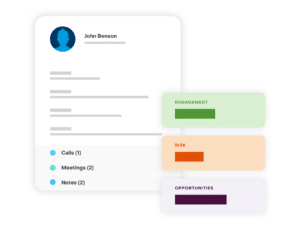How to Use Data for Marketing Without Getting Overwhelmed
More than a decade ago, the world hit a point where the amount of data created across the globe in just two days equaled the amount of data produced from the beginning of civilization to around 2003.
In 2020, an individual’s average amount of data created every second was 1.7 megabytes. That’s enough digital space to store the entire document of Tolstoy’s War and Peace, which is a brick of a book.
If you’re feeling overwhelmed by data these days, it’s for a good reason. And that’s even truer when it comes to business. You already know data is critical to success, and you base decisions on it. But with hundreds or thousands of metaphorical War and Peace volumes flowing your way every second, how do you do that?
You start by not allowing the data to overwhelm you or your organization.
3 Reasons Data Gets Overwhelming
The first reason data becomes overwhelming for businesses is that there’s just so much of it.
The volume of data needed to handoff a single lead into sales, generate conversion, and become a customer is staggering. Repeat that a couple hundred or thousand times and account for data associated with other processes, such as human resources and inventory, and it’s enough to make the mind swirl.
But there are other reasons why data can be overwhelming. Some of them include:
- Data may exist in many places, creating silos. When data exists across multiple systems or channels, it doesn’t work together. It endangers you from making decisions on only part of the story relevant to your customers or business. Also, it means you must manually piece together bits of the story, which takes a lot of time.
- Raw data isn’t helpful for most business processes. Data isn’t always immediately useful, even when it’s all gathered in one location. Unstructured data, which isn’t organized according to specific schema or modeling, doesn’t typically fit in most applications or allow for business use. And even when data is structured, you need special skills or tools to format it into something useful.
- Not all data is the right data. You also need to know how to cull the information you don’t need from the data that’s important in various scenarios. This requires software tools and/or report writing skills.

4 Benefits of Data to Modern Marketers
Businesses can’t simply turn away from data, no matter how overwhelming it may be. Data is a critical resource for modern marketers and sales teams. It gives you vital information about the consumer’s buyer journey and your marketing campaign’s success. Here are just a few benefits of data for marketing:
1. Identify Your Target Audience
Data helps you figure out your target audience, so you don’t waste resources messaging consumers who are not interested in your products. But the benefit goes further: Data also lets you define specifics about your audience to best target your marketing efforts.
For example, you can gather data about where traffic from your website is to see if one social media site drives more traffic than others. That helps you decide which social platforms are more popular with your customer base to concentrate social media marketing and advertising on those channels.
2. Know What’s Working and What’s Not
A/B testing, or split testing, lets you gather data about what is and isn’t working with marketing, so you can continually tweak messaging for more powerful campaigns.
Data can help you decide:
- What topics to blog about, and how long your blog posts should be
- How often to post on social media and what to post about
- When to send marketing emails and how you should write subject lines to promote higher open rates
- Where the calls to action should go on your landing pages
- What types of products might benefit from digital ad campaigns

If you have a question about your marketing and sales processes, you can probably answer it with data.
3. Document ROI and Value
Marketing data also helps you answer questions that might come from others. Stakeholders may wonder if marketing spend generates ROI, or you might have to convince the team that a new social media or ad campaign is a good idea.
One of the best ways to demonstrate the value of various efforts is to document ROI with data.
4. Ability to Segment and Target Marketing Efforts
With the right data, you can divide your audience into segments based on factors such as firmographics, location, technology budget, or interests. That way, you can customize marketing efforts to speak to even more specific needs and wants.
You might go so far as to personalize marketing messages individually. You could address emails directly to specific people, offer a discount on a product someone expressed interest in, or include information relevant to someone’s geolocation. Here are a few examples of how data can help you customize messaging for better engagement:
- A clothing company sends a marketing email highlighting seasonal selections that are a fit for someone’s regional climate
- A service company sends an email reminding someone of their annual service date
- Emails are timed to hit inboxes at optimal times based on demographics like age, career status, or time zone
5. Invest in Improvements to Services and Goods
Marketing data can also help you gather insights to suggest improvements to goods or services. You can then offer those upgraded products to new leads and existing customers.
7 Tips for Putting Data to Work for Your Organization
Pushing past overload to get used out of your data does take practice. It also takes a plan and some specific tools. Check out the steps below that can help you use data for positive purposes within your organization.
1. Start with Solid and Business-Focused Goals
Like any other resource, data doesn’t work magically. You need a direction before you start using data to get you there. Begin by creating data-focused business goals for your organization.
Strong goals are:
- Challenging but realistic
- Specific and measurable
- Capped by a deadline
- Concerned with positive impacts to your business

Let’s look at some weak and strong business goals to understand better:
1. Weak: Improve marketing to increase sales and revenue numbers. It’s not specific, and there’s no deadline. You could measure sales and revenue numbers, but how do you know when you’ve succeeded?
Strong: Increase conversion rates on the website by 10% year-over-year by the end of Q3. The goal is specific, can be measured, and sets a deadline.
2. Weak: Increase Facebook likes on posts to an average of 100 by September. While this seems like a strong goal because it’s specific, measurable, and has a deadline, it’s not business-facing. Likes are a vanity metric and have nothing to do with actual sales or revenue for your company.
Strong: Increase click-through rates from social posts by 5% month-over-month by June. Click-through rates are not a vanity metric. They measure a potential lead, which is business-facing.
2. Know what data you need to track goal progress
Once you set your goals, decide what data you need to track progress toward them.
For example, if your goal is to reduce the cost of acquisitions, you’ll need data such as:
- Sources of leads
- Cost per lead for various channels
- How many leads become customers per channel
Ensure you have access to each type of data you need to track your goals. Then get a baseline measurement; this is the measurement of where you are before you make any effort toward your goal. Knowing where you started from helps you understand how far you got toward your goal, and that is important if you don’t hit the success metric.
For example, imagine a scenario where the goal is to increase sales by 100 deals in one month. There’s a huge difference in increasing sales by 20 deals and increasing them by 90 deals. Both fall short of the goal, but the latter is much more successful and very close.
3. Invest in a Strong Analytics Tool
Review options for marketing analytics tools. These platforms let you automate data capture, reduce data silos, and present important data in a format that’s easy to use by the business. They can also help reduce data overload by providing viable methods for working with and reporting data.
4. Make Analytics a Part of your Daily Processes
Ensure you use analytics tools to manage daily processes. If possible, create a dashboard that lets leadership see where things stand with key performance indicators in real-time or at least daily. It helps you understand if it’s necessary to make changes in your processes or action plan to move toward your goal. It also helps ensure continual buy-in from leadership on campaigns, especially if you can point to data that shows movement toward the goal.

5. Create a Plan of Action
Once you have a goal, a way to measure progress, and access to those numbers regularly, create and implement a plan of action.
For example, if your goal is to increase the percentage of leads you convert, you might plan email nurture campaigns. When the goal is to drive more traffic to your website, you might consider a plan that involves search engine optimization, PPC ads, and linking campaigns.
As you can see, the plan must be relevant to your goals. You can even turn to data to help you come up with it. Look at past marketing efforts to find campaigns that generated the type of results you’re looking for. If you want to increase sales and a certain type of email campaign helped you do that in the past, ask yourself how you can replicate that success.
6. Give Your Plan Time to Work
Balance the necessary tweaks to a process that isn’t driving results with time to allow your plan to work. For example, if you send an email marketing campaign out at 9:00 am on a Tuesday, you can’t call it a failure at 2:00 pm the same day and immediately change tactics.
Different types of marketing efforts take longer to work than others. Email marketing and ad campaigns tend to be the fastest, often generating results in days or weeks. However, SEO and social media marketing may take months to generate results.
Remember that instant access to data is great, but it doesn’t always mean instant plans change.
7. Conduct a Debrief
Whether you met the goal on time or not, gather the team involved and use data from the process to conduct a debrief. What worked? What didn’t? How could you put it over the top next time if you were very close to the goal? If you fell very short, why? The data from your campaign can tell a story about what happened and why so you can make improvements for the following efforts.
Don’t Let Data Overwhelm You: Get Help
Sugar Market is a marketing automation platform that helps you gather data, plan marketing campaigns, and execute conversion efforts.
Contact us today to find out more about how Sugar Market can help your organization. You can also request a live demo of the product to understand how it might fit into your processes.



